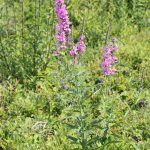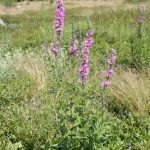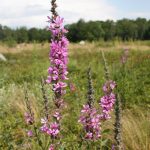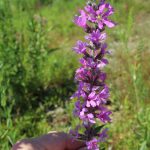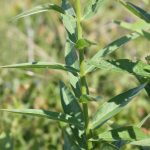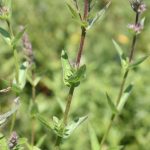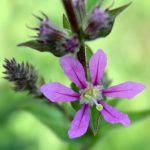Purple loosestrife
Prepared by Jennifer L. D’Appollonio, Assistant Scientist, University of Maine, Orono, ME 04469. Updated April 2019.
Scientific name: Lythrum salicaria L.
Common name(s): purple loosestrife
Links: USDA PLANTS Profile, Go Botany
Images: (to see enlargements [PC]: click on image, then right click and choose “view image”)
- flowering, late July
- lower leaves
- upper leaves
- flower has 6 petals
- robust individuals in wet swale in blueberry field
- spreading from wet swale
- spreading from wet area to dry sandy area
Description:
-perennial
-considered an invasive species
-leaves are:
- simple
- opposite
- whorled
Habitats:
-sun
-wetlands
-disturbed areas
-meadows and fields
-marshes
-shores of rivers
Agriculture:
-displaces native plants
-decreases plant and animal diversity
- competition with purple loosestrife has been suggested as a contributing factor in the decline of the rare Long’s bulrush (Scirpus longii) in Massachusetts
– will hybridize with European wand loosestrife (Lythrum virgatum) and winged loosestrife (Lythrum alatum)
-grazed by white tailed deer, muskrat, and rabbits
-American coot, pied-billed grebe, black-crowned night heron, American goldfinch and gray catbird have all been observed nesting in purple loosestrife stands
-provides little to no food source for birds
-colonization can substantially reduce or eliminate open water in small marsh areas
– Important aquatic food plants for wildlife such as pondweeds (Potamogeton spp.) are inhibited under the shade of purple loosestrife
-Invading purple loosestrife in coastal British Columbia’s Fraser River estuary may have negative effects on detrital food chains
Management:
-eliminate small recent patches first with digging or hand pulling
-encourage establishment of native woody cover to create shade
-avoid disturbance
-high water conditions slow its growth
-cutting stems or removing flower heads
-beetles and weevils have been released to control purple loosestrife
-herbicides that have been used effectively against purple loosestrife in North America
- 2, 4-D
- Mixed results against purple loosestrife; harmful to dicots, but little impact on neighboring monocots
- Triclopyr
- Generally effective at killing purple loosestrife; results are variable with spray volume; selective against dicots
- Glyphosate
- Highly effective against purple loosestrife; specific formulations available for use in aquatic environments; also damages or kills most other plants which it contacts
- Imazapyr
- Effective against purple loosestrife; negatively impacts cattail
Natural History:
-native to Eurasia
-it was well established by the 1830s within coastal wetlands along the New England seaboard,
- introduced via ship ballast soil.
- Initial spread of purple loosestrife into the interior of eastern North America occurred primarily via routes of maritime commerce, such as canals, rivers and the Great Lakes
Sources:
U.S. Forest Service. “Lythrum Salicaria.” Fire Effects Information System (FEIS), USDA, 2020, www.fs.fed.us/database/feis/plants/forb/lytsal/all.html.
Go Botany. “Lythrum Salicaria L.” Lythrum Salicaria (Purple Loosestrife): Go Botany, 2020, gobotany.nativeplanttrust.org/species/lythrum/salicaria/.

